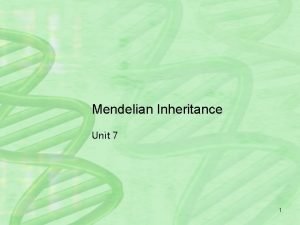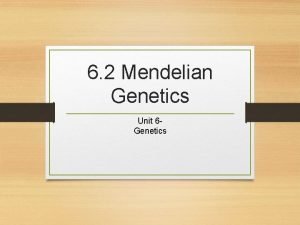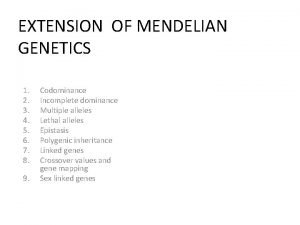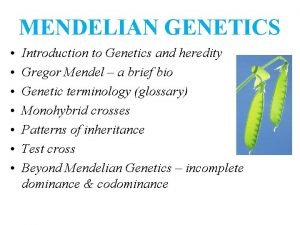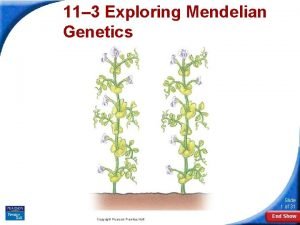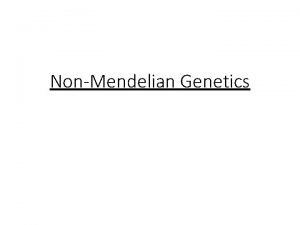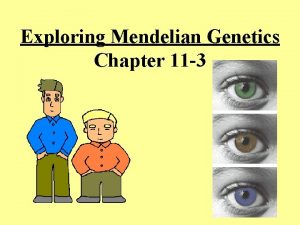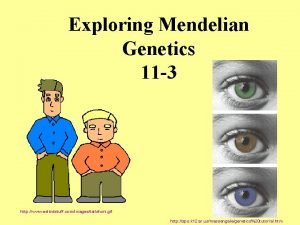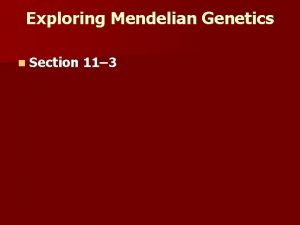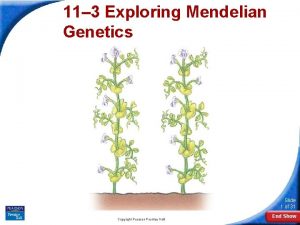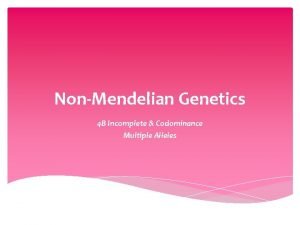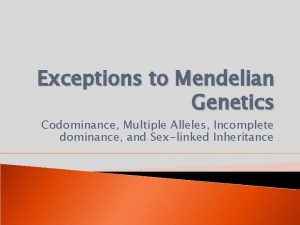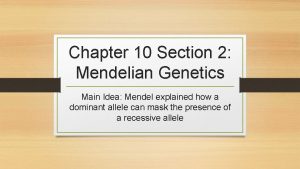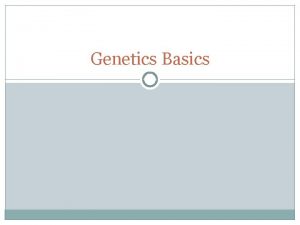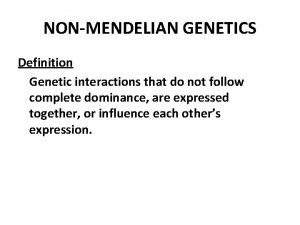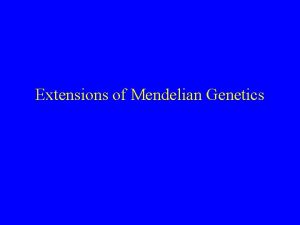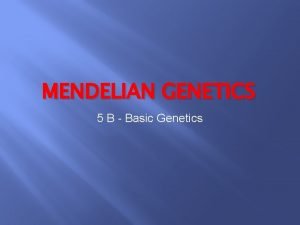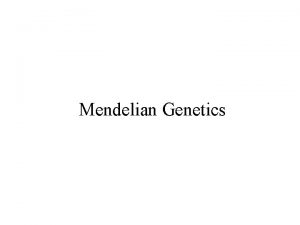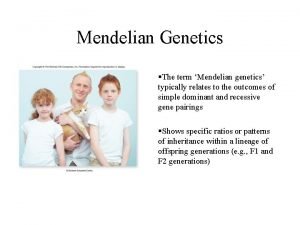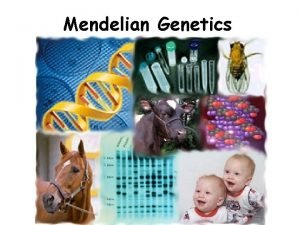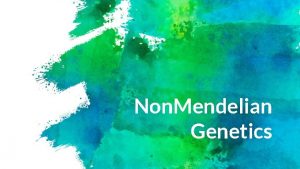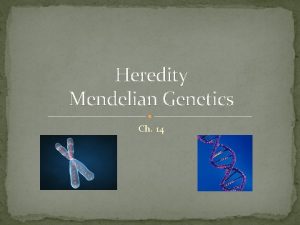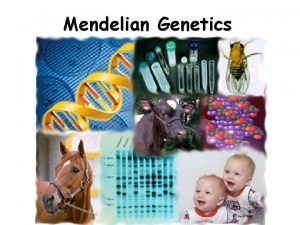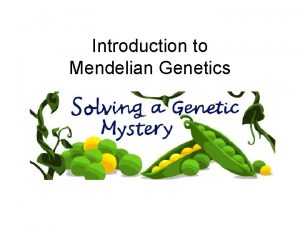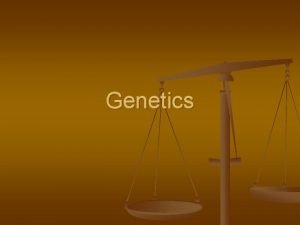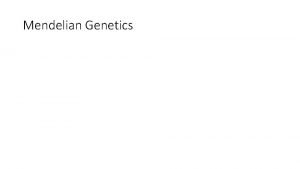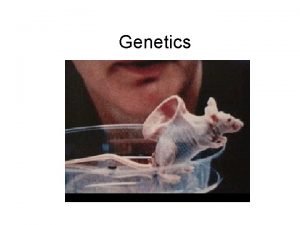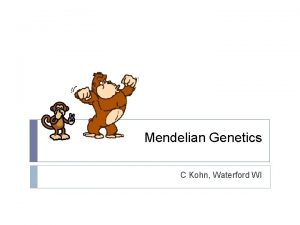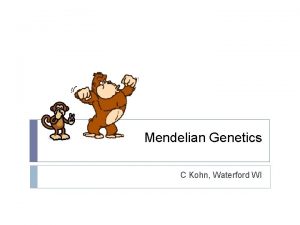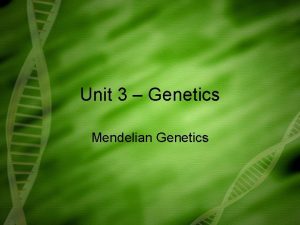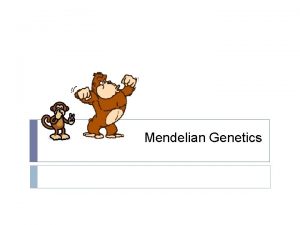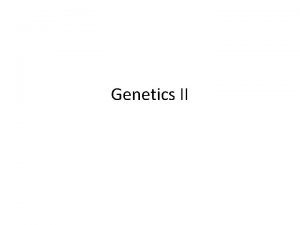Mendelian Genetics Concept 2 Analyzing the effects of


























- Slides: 26

Mendelian Genetics Concept 2: Analyzing the effects of complex genetic crosses such as incomplete/co- dominance, multiple alleles, pleiotropy, epistasis, polygenics, and lethal alleles.

We just need to practice… Try… On Worksheets: Multiple Choice: 1, 2, 3, 5, 7, 8, 10, 13 Genetics Problems: 1, 2, 6, 12, 13 s t i a r re t a w o H : l m a o r o f G n g w ? n o i g d n n r i d r Lea passe o offsp t s t n e r a p

Try This! A brown eyed male has 5 children with a blue eyed female. 4 of the children have brown eyes and 1 child has blue eyes. If brown eyes are dominant to blue eyes, what is the genotype of each parent?

Degrees of Dominance Complete Dominance Homozygous Dominant and Heterozygous are indistinguishable Monohybrid Phenotypic Ratio – 3: 1 Incomplete Dominance Heterozygotes display a blended phenotype Monohybrid Phenotypic Ratio – 1: 2: 1 Codominance Heterozygotes display both traits (separate, distinguishable) Monohybrid Phenotypic Ratio - 1: 2: 1

Degrees of Dominance Not cut and dry… Organism Biochemical Molecular

Multiple Alleles Many alleles for one gene Blood Type Example: If a male with blood type AB has children with a female with blood type O, what is the predicted phenotypic ratio of their children?

Multiple Alleles Example: If a male with blood type AB has children with a female with blood type O, what is the predicted phenotypic ratio of their children? Type AB male x Type O Female IAIB ii IA i i IB

Multiple Alleles Example: If a male with blood type AB has children with a female with blood type O, what is the predicted phenotypic ratio of their children? Type AB male x Type O Female IAIB ii i i IA IAi IB IBi

Multiple Alleles Example: If a male with blood type AB has children with a female with blood type O, what is the predicted phenotypic ratio of their children? Type AB male x Type O Female IAIB ii i i IA IAi IB IBi Predicted Phenotypic Ratio:

Multiple Alleles Example: If a male with blood type AB has children with a female with blood type O, what is the predicted phenotypic ratio of their children? Type AB male x Type O Female IAIB ii i i IA IAi IB IBi Predicted Phenotypic Ratio: 1 Type A: 1 Type B

Pleiotropy One gene that has multiple effects on phenotypic characters Sickle cell Cystic fibrosis

Epistasis One gene having an effect over another gene Mouse coat colour Example: In corn, a dominant allele I inhibits kernel colour, while the recessive allele i permits colour when homozygous. At a different locus, the dominant allele P causes purple kernel colour, while the homozygous genotype pp causes red kernels. If plants heterozygous at both loci are crossed, what will be the phenotypic ratio of the offspring?

Epistasis § Example: In corn, a dominant allele I inhibits kernel colour, while the recessive allele i permits colour when homozygous. At a different locus, the dominant allele P causes purple kernel colour, while the homozygous genotype pp causes red kernels. If plants heterozygous at both loci are crossed, what will be the phenotypic ratio of the offspring? (no colour=yellow) Ii. Pp x Ii. Pp Phenotypes: I i I II Ii ii P p P PP Pp pp

Epistasis § Example: In corn, a dominant allele I inhibits kernel colour, while the recessive allele i permits colour when homozygous. At a different locus, the dominant allele P causes purple kernel colour, while the homozygous genotype pp causes red kernels. If plants heterozygous at both loci are crossed, what will be the phenotypic ratio of the offspring? (no colour=yellow) Ii. Pp x Ii. Pp Phenotypes: Yellow I___ Purple ii. P_ Red iipp I i I II Ii ii P p P PP Pp pp

Epistasis § Example: In corn, a dominant allele I inhibits kernel colour, while the recessive allele i permits colour when homozygous. At a different locus, the dominant allele P causes purple kernel colour, while the homozygous genotype pp causes red kernels. If plants heterozygous at both loci are crossed, what will be the phenotypic ratio of the offspring? (no colour=yellow) Ii. Pp x Ii. Pp Phenotypes: Yellow I___ Purple ii. P_ Red iipp I i I II Ii 1 x ¾ = 12/16 ¾ x ¼ = 3/16 ¼ x ¼ = 1/16 i Ii ii P p P PP Pp pp

Epistasis § Example: In corn, a dominant allele I inhibits kernel colour, while the recessive allele i permits colour when homozygous. At a different locus, the dominant allele P causes purple kernel colour, while the homozygous genotype pp causes red kernels. If plants heterozygous at both loci are crossed, what will be the phenotypic ratio of the offspring? (no colour=yellow) Ii. Pp x Ii. Pp Phenotypes: Yellow I___ Purple ii. P_ Red iipp I i I II Ii 1 x ¾ = 12/16 ¾ x ¼ = 3/16 ¼ x ¼ = 1/16 i Ii ii P p P PP Pp pp Predicted Phenotypic Ratio:

Epistasis § Example: In corn, a dominant allele I inhibits kernel colour, while the recessive allele i permits colour when homozygous. At a different locus, the dominant allele P causes purple kernel colour, while the homozygous genotype pp causes red kernels. If plants heterozygous at both loci are crossed, what will be the phenotypic ratio of the offspring? (no colour=yellow) Ii. Pp x Ii. Pp Phenotypes: Yellow I___ Purple ii. P_ Red iipp I i I II Ii 1 x ¾ = 12/16 ¾ x ¼ = 3/16 ¼ x ¼ = 1/16 i Ii ii P p P PP Pp pp Predicted Phenotypic Ratio: 12 Yellow: 3 Purple: 1 Red

Polygenic Inheritance Two or more genes affecting one phenotypic character Quantitative characters – continuum rather than “either/or” Skin colour in humans Spike weed height Number of phenotypic classes possible = #alleles+1

Try This! The height of spike weed is a result of polygenetic inheritance involving three genes, each of which can contribute an additional 5 cm to the base height of the plant, which is 10 cm. The tallest plant (AABBCC) can reach a height of 40 cm. A) If a tall plant (AABBCC) is crossed with a base-height plant (aabbcc), what is the height of the F 1 plants? B) How many phenotypic classes will there be in the F 2? c) What is the probability of seeing a 20 cm plant in the F 2 generation?

A) If a tall plant (AABBCC) is crossed with a base-height plant (aabbcc), what is the height of the F 1 plants? The parental cross produced 25 cm tall F 1 plants, all Aa. Bb. Cc plants with 3 units of 5 cm added to the base height of 10 cm.

B) How many phenotypic classes will there be in the F 2? General Rule: number of phenotypic classes resulting from a cross of heterozygotes equals the number of alleles involved plus one. (Aa. Bb. Cc ) 6 alleles + 1 = 7 6 dominant alleles: 40 cm 5: 35 cm 4: 30 cm 3: 25 cm 2: 20 cm 1: 15 cm 0: 10 cm

c) What is the probability of seeing a 20 cm plant in the F 2 generation? Phenotype: 20 cm Genotype: 2 dominant alleles Aa. Bb. Cc x Aa. Bb. Cc AAbbcc Aa. Bbcc Aabb. Cc aa. BBcc aa. Bb. Cc aabb. CC ¼ x ¼ = 1/64 ½ x ¼ = 1/16 = 4/64 ½ x ¼ x ½ = 1/16 = 4/64 ¼ x ¼ = 1/64 Different ways of getting the same thing… add! 15/64

Lethal Alleles Recessive lethal allele 2: 1 ratio if lethal before birth Cystic fibrosis Dominant lethal allele Must show effects after reproductive age Why? Huntington’s Disease

Environmental Effects Hydrangeas Plant a tin can next to them and see what happens!

Don’t forget about pedigrees!

We just need to practice… On Worksheets for Concept 2: Multiple Choice: 4, 6, 9, 11, 12, 14, 15, 16 Genetics Problems: 3, 4, 5, 7, 8, 9, 10, 11, 14 s t i a r re t a w o H : l m a o r o f G n g w ? n o i g d n n r i d r Lea passe o offsp t s t n e r a p
 Heredity concept map
Heredity concept map Family resemblance test
Family resemblance test Mendelian genetics punnett square
Mendelian genetics punnett square Purebred vs hybrid
Purebred vs hybrid Extension of mendelian genetics
Extension of mendelian genetics Chapter 7 extending mendelian genetics vocabulary practice
Chapter 7 extending mendelian genetics vocabulary practice Codominant biology definition
Codominant biology definition Codominace
Codominace Section 11-3 exploring mendelian genetics
Section 11-3 exploring mendelian genetics The scientific study of heredity *
The scientific study of heredity * Multiple alleles
Multiple alleles Section 11-3 exploring mendelian genetics answer key
Section 11-3 exploring mendelian genetics answer key 11-3 exploring mendelian genetics
11-3 exploring mendelian genetics Section 11-3 exploring mendelian genetics
Section 11-3 exploring mendelian genetics Mendelian principles of genetics
Mendelian principles of genetics Section 11-3 exploring mendelian genetics
Section 11-3 exploring mendelian genetics Codominance definition
Codominance definition Section 11-3 exploring mendelian genetics answer key
Section 11-3 exploring mendelian genetics answer key Extending mendelian genetics
Extending mendelian genetics Hors xnxn
Hors xnxn Chapter 10 section 2 mendelian genetics answer key
Chapter 10 section 2 mendelian genetics answer key Pedigree miscarriage symbol
Pedigree miscarriage symbol Karyotype
Karyotype Carrier female genotype
Carrier female genotype Type a heterozygous blood
Type a heterozygous blood Describe incomplete dominance
Describe incomplete dominance H antigen
H antigen

